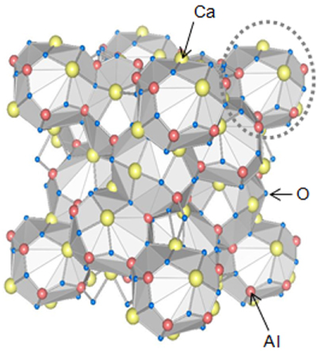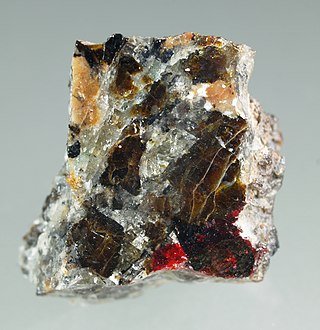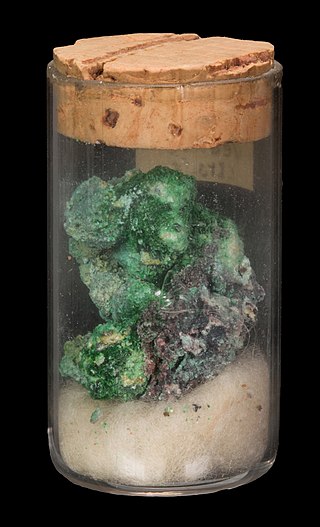Related Research Articles

Mimetite is a lead arsenate chloride mineral (Pb5(AsO4)3Cl) which forms as a secondary mineral in lead deposits, usually by the oxidation of galena and arsenopyrite. The name derives from the Greek Μιμητής mimetes, meaning "imitator" and refers to mimetite's resemblance to the mineral pyromorphite. This resemblance is not coincidental, as mimetite forms a mineral series with pyromorphite (Pb5(PO4)3Cl) and with vanadinite (Pb5(VO4)3Cl). Notable occurrences are Mapimi, Durango, Mexico and Tsumeb, Namibia.

Bentorite is a mineral with the chemical formula Ca6(Cr,Al)2(SO4)3(OH)12·26H2O. It is colored violet to light violet. Its crystals are hexagonal to dihexagonal dipyramidal. It is transparent and has vitreous luster. It has perfect cleavage. It is not radioactive. Bentorite is rated 2 on the Mohs scale.

Chlormayenite (after Mayen, Germany), Ca12Al14O32[☐4Cl2], is a rare calcium aluminium oxide mineral of cubic symmetry.

Tsumebite is a rare phosphate mineral named in 1912 after the locality where it was first found, the Tsumeb mine in Namibia, well known to mineral collectors for the wide range of minerals found there. Tsumebite is a compound phosphate and sulfate of lead and copper, with hydroxyl, formula Pb2Cu(PO4)(SO4)(OH). There is a similar mineral called arsentsumebite, where the phosphate group PO4 is replaced by the arsenate group AsO4, giving the formula Pb2Cu(AsO4)(SO4)(OH). Both minerals are members of the brackebuschite group.
This list gives an overview of the classification of non-silicate minerals and includes mostly International Mineralogical Association (IMA) recognized minerals and its groupings. This list complements the List of minerals recognized by the International Mineralogical Association series of articles and List of minerals. Rocks, ores, mineral mixtures, not IMA approved minerals, not named minerals are mostly excluded. Mostly major groups only, or groupings used by New Dana Classification and Mindat.
The Hatrurim Formation or Mottled Zone is a geologic formation with outcrops all around the Dead Sea Basin: in the Negev Desert in Israel, in the Judaean Desert on the West Bank, and in western Jordan. It includes late Cretaceous to Eocene aged impure limestone along with coal bearing chalk and marl. The rocks have been subjected to pyrometamorphism resulting from combustion of contained or underlying coal or hydrocarbon deposits. The formation is named for exposures in the Hatrurim Basin which lies west of the Dead Sea.

Perhamite is a phosphate mineral with the formula Ca3Al7(SiO4)3(PO4)4(OH)3·16.5(H2O). It occurs in rare isolated masses in amblygonite-rich pegmatite deposits throughout the world. It was discovered in platy sheed form of 1mm hexagonal crystals. It was first described in 1977 by P.J. Dunn and D.E. Appleman from pegmatite collected from Bell Pit, Newry, Maine. Other specimens have been found in Kapunda, South Australia, in Silver Coin mine near Humboldt County, Nevada and various locations throughout Europe.
Penikisite was discovered by Alan Kulan and Gunar Penikis near Rapid Creek, Yukon Territory. The mineral is a member of the bjarebyite group along with kulanite, ideally BaFe2+2Al2(PO4)3(OH)3, and bjarebyite, ideally BaMn2+2Al2(PO4)3(OH)3. It is among several new minerals that have been discovered in the Rapid Creek and Big Fish areas of Yukon Territory. Kulanite is similar in many ways to penikisite in appearance and properties. The chemical formula for penikisite is Ba(Mg,Fe,Ca)Al2(PO4)2(OH)3. It has a hardness of about 4 and a density of 3.79 g/cm3. Penikisite is unique among the bjarebyite group in being monoclinic and has a biaxial optical class. It comes in shades of blue and green and, when rubbed on a streak plate, is pale green to white in color. Although penikisite and kulanite both range from blue to green, penikisite zones are easily distinguishable from kulanite zones in kulanite-penikisite crystals because they are lighter than the darker kulanite in color. Penikisite is a phosphate and is different from kulanite in that it is a magnesium-rich phosphate whereas kulanite is an iron-rich phosphate.
Aradite is a very rare mineral with formula BaCa6[(SiO4)(VO4)](VO4)2F. Aradite and its phosphorus-analogue, zadovite, were found in paralavas (rocks formed due to pyrometamorphism) of the Hatrurim Formation. Both aradite and zadovite have structures similar to that of nabimusaite. Structure of all three minerals is related to that of hatrurite.
Pyrometamorphism is a type of metamorphism in which rocks are rapidly changed by heat, e.g. coming from a rapidly emplaced extrusive or intrusive igneous rock or from a fossil fuel fire. The rocks produced by pyrometamorphism include buchite, clinker and paralava, formed due to melting and/or recrystallisation of sedimentary rocks. Both natural and anthropogenic examples of sites with active pyrometamorphism are known. One well-known area of natural pyrometamorphic rocks is the Hatrurim Formation with outcrops all around the Dead Sea Basin: in the Negev Desert in Israel, in the Judaean Desert on the West Bank, and in western Jordan. Xenoliths of sedimentary rocks trapped in volcanic lava may undergo pyrometamorphic transformation, as can some contact wallrocks. Anthropogenic pyrometamorphic rocks are found in burning coal-mining dumps. A great number of minerals, sometimes very rare, are found within these rocks. Of the silicate minerals, the typical ones are especially cordierite, indialite, fayalite, mullite, tridymite and cristobalite, and sekaninaite. Oxide minerals include corundum, hematite, hercynite, magnesioferrite, and magnetite. Some rare minerals typical of meteorites, like oldhamite, are also found in pyrometamorphic rocks.
Nabimusaite is a very rare mineral with formula KCa12(SiO4)4(SO4)2O2F. Its structure, as in case of similar aradite and zadovite, is a derivative of the one of hatrurite. Nabimusaite gives its name to the nabimusaite group. The mineral was found in a pyrometamorphic rock of the Hatrurim Formation, a site known for the natural pyrometamorphism. It is interpreted to have formed due to interaction of a precursor assemblage with sulfate-rich melt. Nabimusaite is potassium- and fluorine-analogue of dargaite.

Gurimite is a rare mineral with formula Ba3(VO4)2. It is a simple barium vanadate, one of the most simple barium minerals known. It is named after its type locality - Gurim anticline in Israel. It has formed in the rocks of the Hatrurim Formation. Gurimite's stoichiometry is similar to that of copper vanadates mcbirneyite and pseudolyonsite. An example of other barium vanadate mineral is tokyoite.
Dargaite is a rare mineral with formula BaCa12(SiO4)4(SO4)2O3. It is the barium-analogue of nabimusaite, also differing from it in the lack of fluorine. It is one of many recently approved new minerals coming from the Hatrurim complex. Dargaite, as nabimusaite, is trigonal (space group R-3m).
Hexacelsian is a rare barium silicate mineral with the formula BaAl2Si2O8. It was discovered in the Hatrurim Basin in Israel, where the Hatrurim Formation of rocks formed due to exposed pyrometamorphism.

Shulamit Gross was an Israeli mineralogist and geologist who studied the Hatrurim Formation.
The fluoride phosphates or phosphate fluorides are inorganic double salts that contain both fluoride and phosphate anions. In mineralogy, Hey's Chemical Index of Minerals groups these as 22.1. The Nickel-Strunz grouping is 8.BN.

Euchlorine (KNaCu3(SO4)3O) is a rare emerald-green sulfate mineral found naturally occurring as a sublimate in fumaroles around volcanic eruptions. It was first discovered in fumaroles of the 1868 eruption at Mount Vesuvius in Campania, Italy by Arcangelo Scacchi. The name 'euchlorine' comes from the Greek word εΰχλωρος meaning "pale green" in reference to the mineral's color, other reported spellings include euclorina, euchlorin, and euchlorite.

Fumarole minerals are minerals which are deposited by fumarole exhalations. They form when gases and compounds desublimate or precipitate out of condensates, forming mineral deposits. They are mostly associated with volcanoes following deposition from volcanic gas during an eruption or discharge from a volcanic vent or fumarole, but have been encountered on burning coal deposits as well. They can be black or multicoloured and are often unstable upon exposure to the atmosphere.
References
- ↑ Warr, L.N. (2021). "IMA–CNMNC approved mineral symbols". Mineralogical Magazine. 85 (3): 291–320. Bibcode:2021MinM...85..291W. doi: 10.1180/mgm.2021.43 . S2CID 235729616.
- 1 2 "Aradite: Aradite mineral information and data". Mindat.org. Retrieved 2016-03-02.
- ↑ Galuskin, E.V., Gfeller, F., Galuskina, I.O., Pakhomova, A., Armbruster, T., Vapnik, Y., Włodyka, R., Dzierżanowski, P., and Murashko, M., 2015. New minerals with a modular structure derived from hatrurite from the pyrometamorphic Hatrurim Complex. Part II. Zadovite, BaCa6[(SiO4)(PO4)](PO4)2F and aradite, BaCa6[(SiO4)(VO4)](VO4)2F, from paralavas of the Hatrurim Basin, Negev Desert, Israel. Mineralogical Magazine 79(5), 1073-1087
- ↑ Galuskin, E.V., Gfeller, F., Armbruster, T., Galuskina, I.O., Vapnik, Y., Murashko, M., Włodyka, R., and Dzierżanowski, P., 2015. New minerals with a modular structure derived from hatrurite from the pyrometamorphic Hatrurim Complex. Part I. Nabimusaite, KCa12(SiO4)4(SO4)2O2F, from larnite rocks of Jabel Harmun, Palestinian Autonomy, Israel. Mineralogical Magazine 79(5), 1061-1072